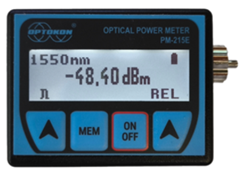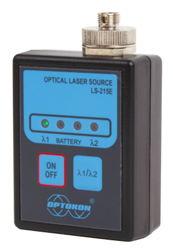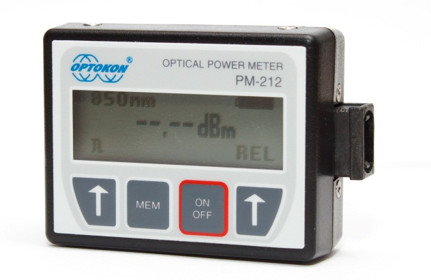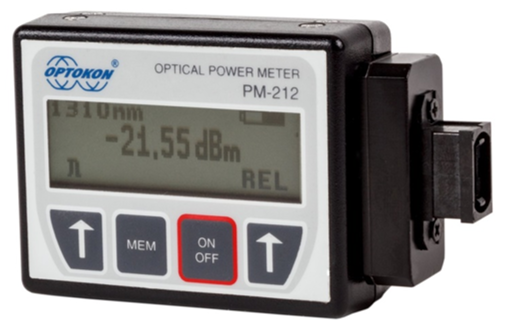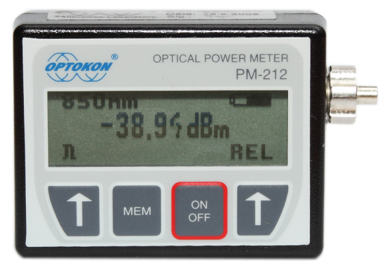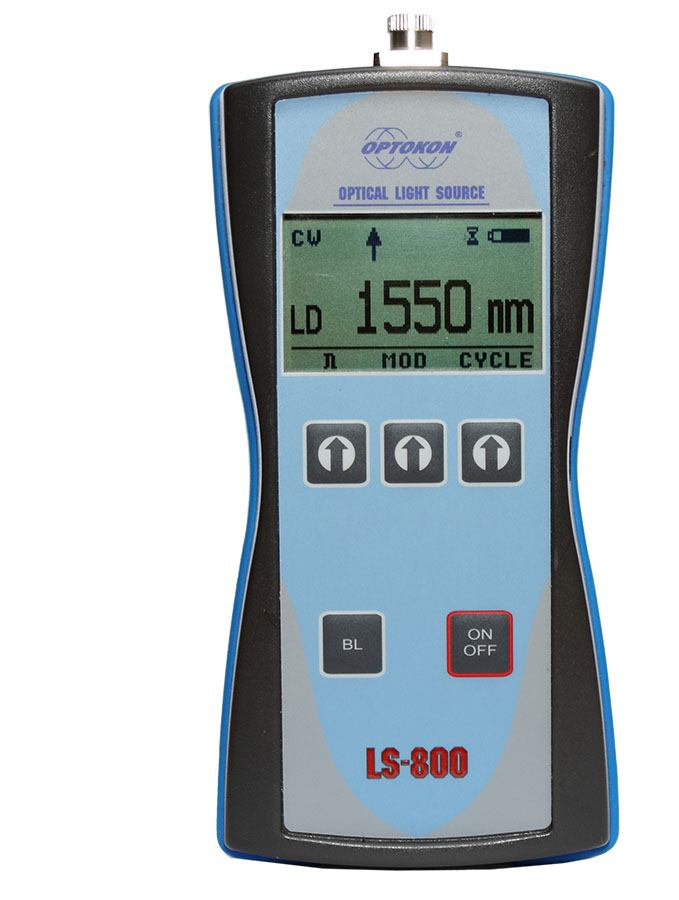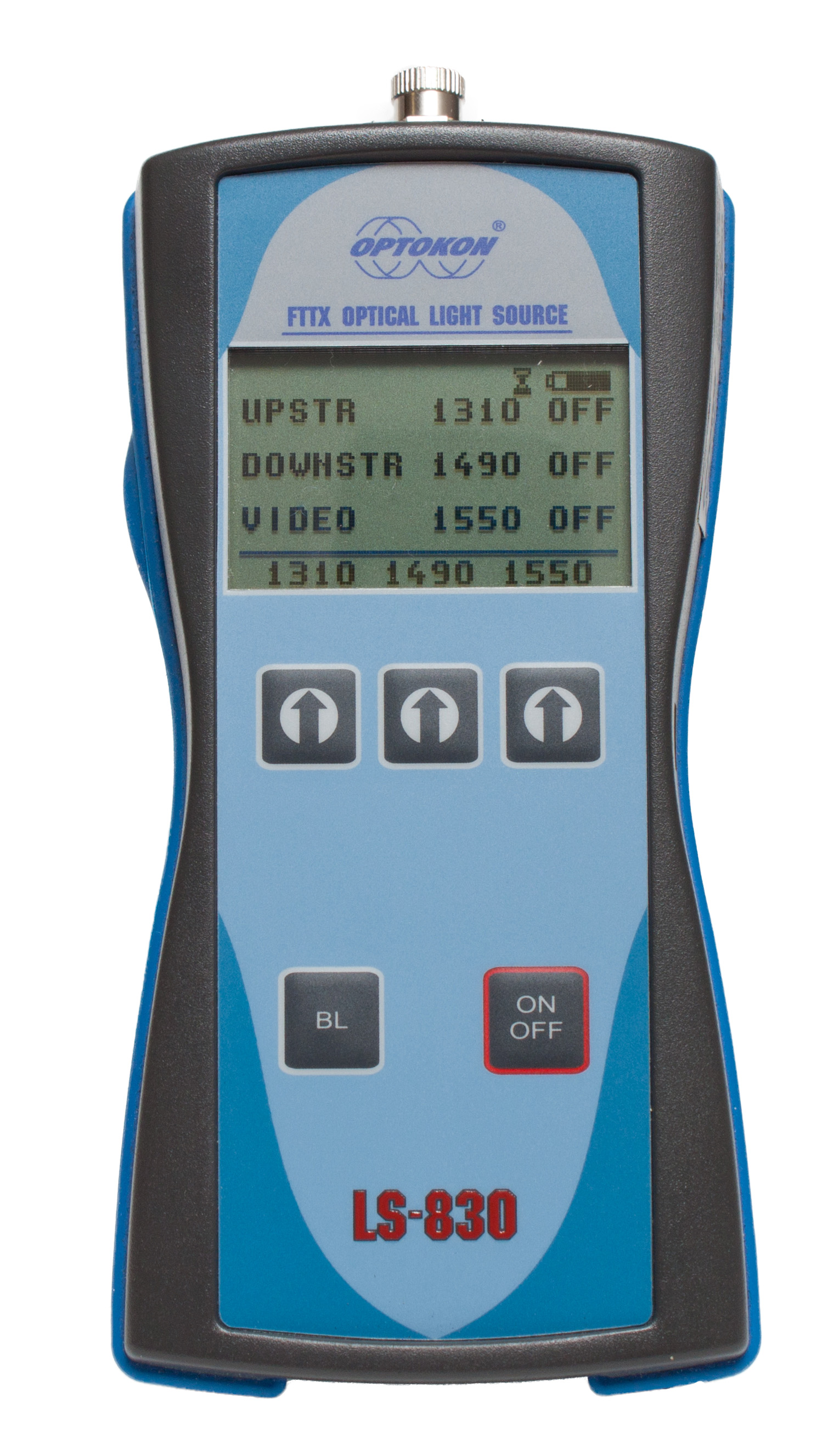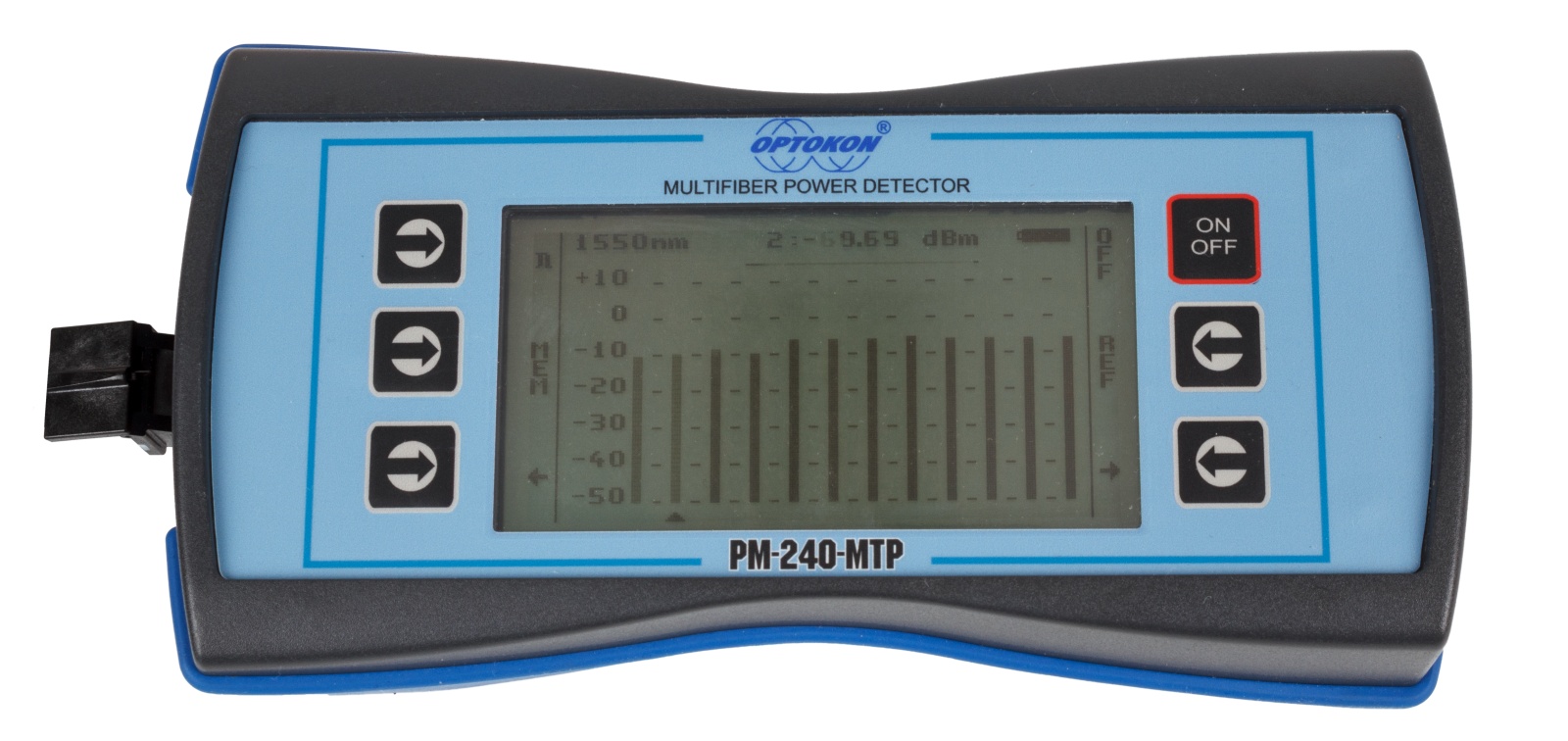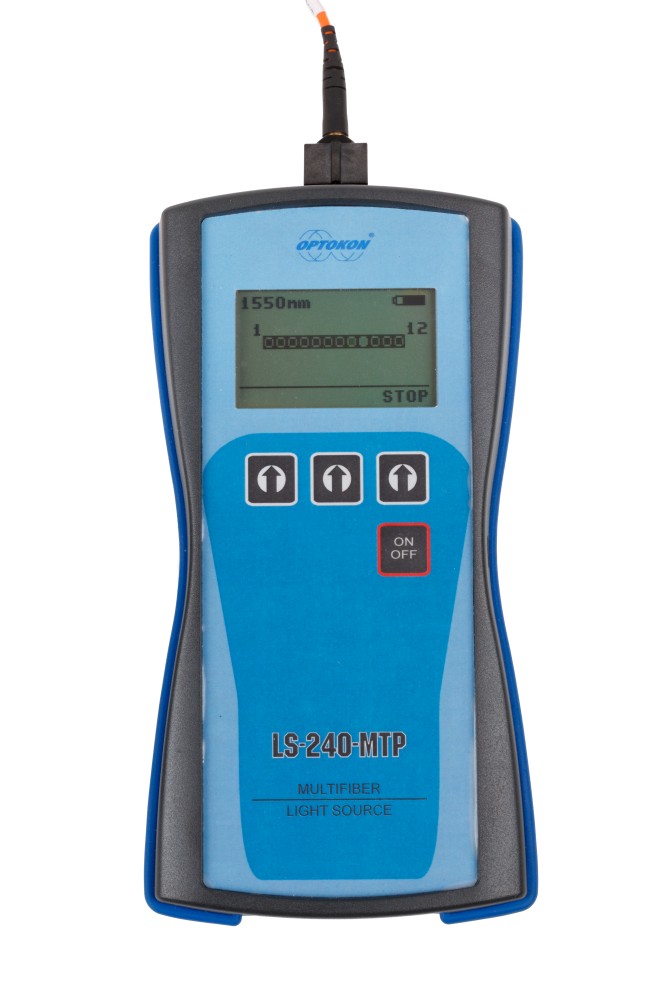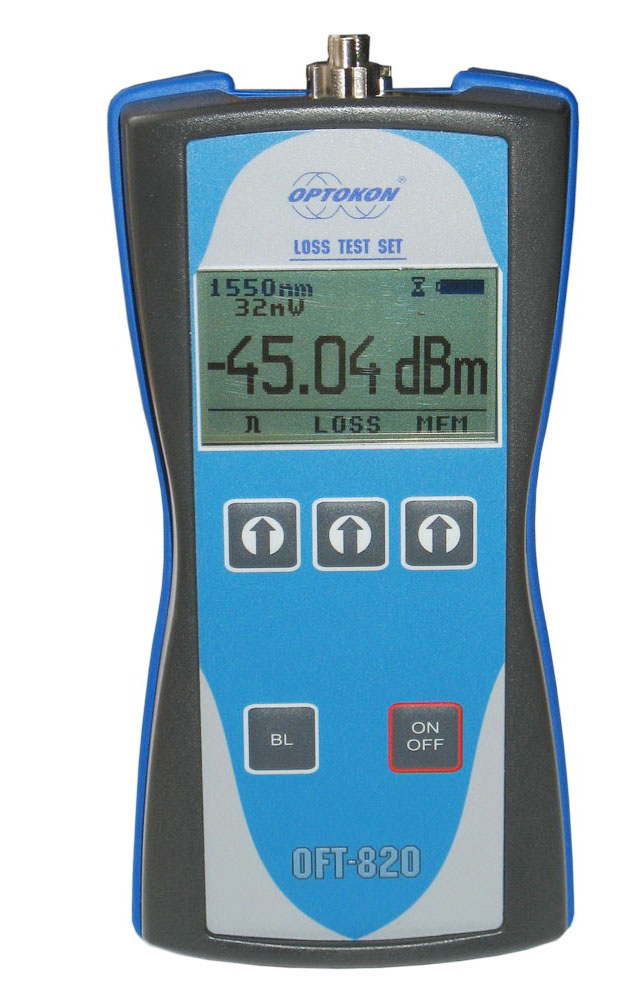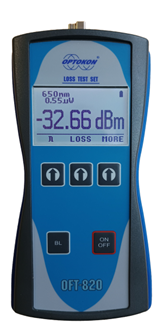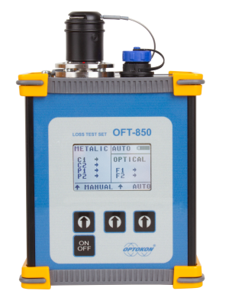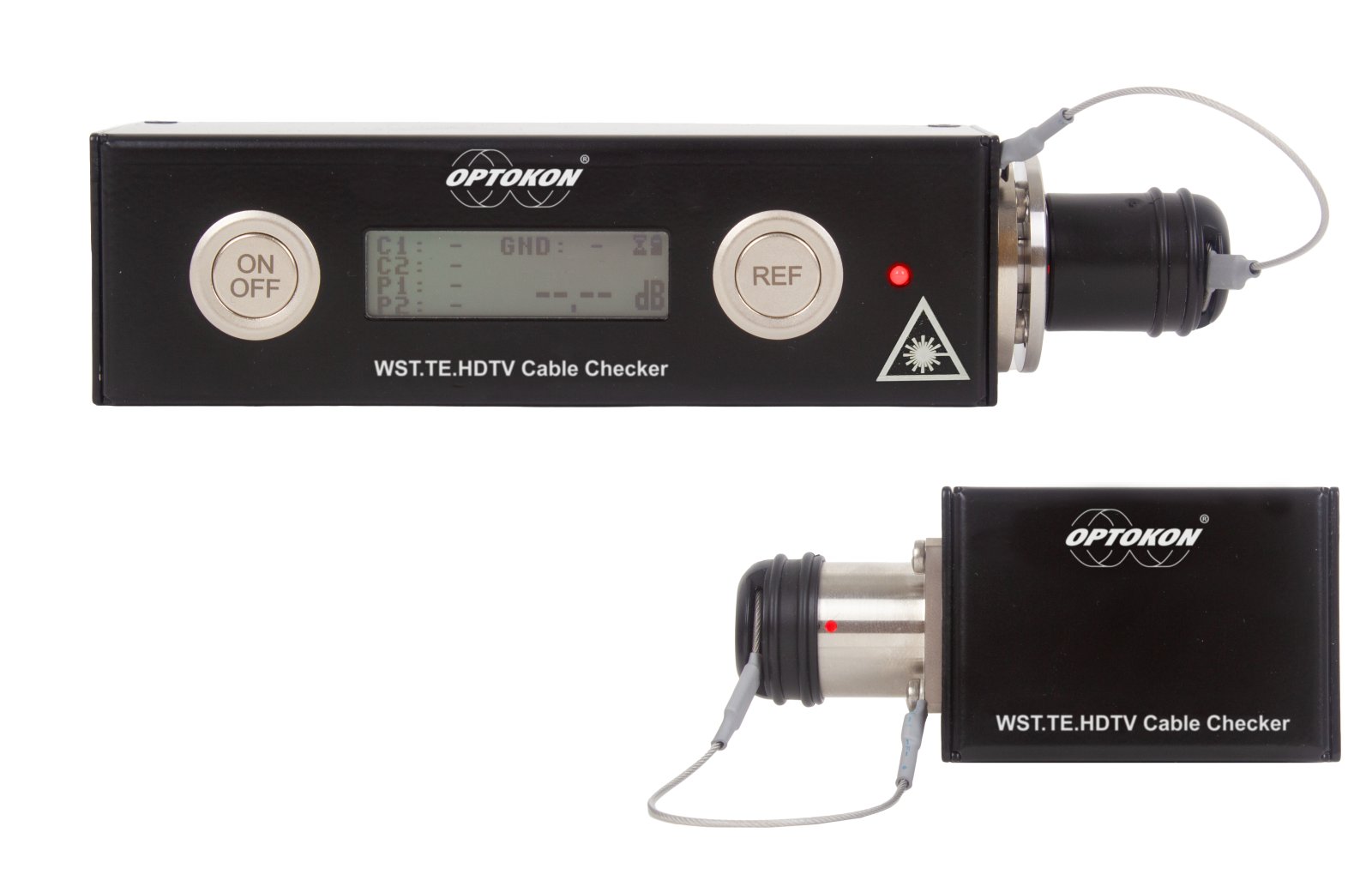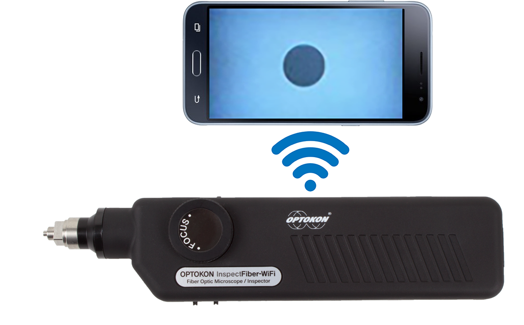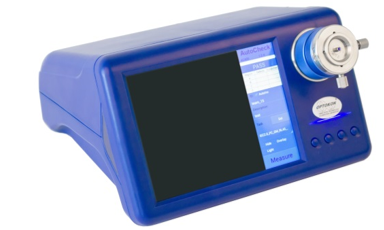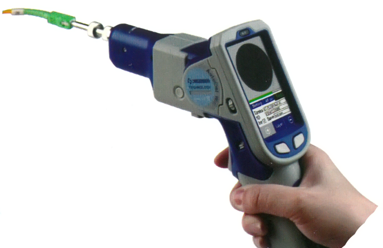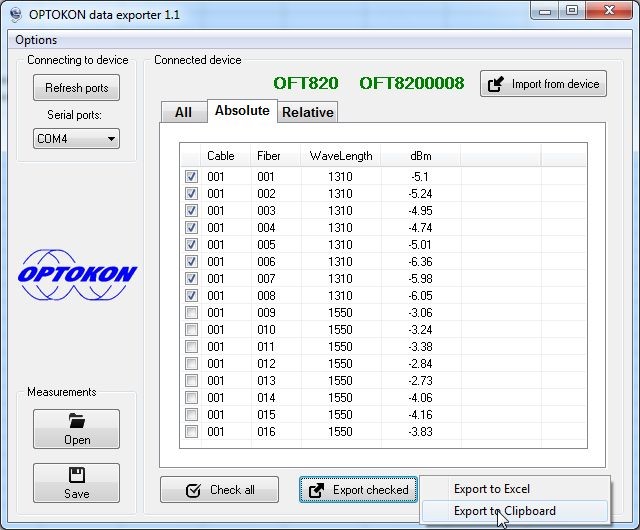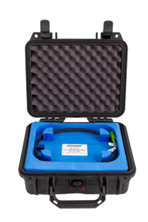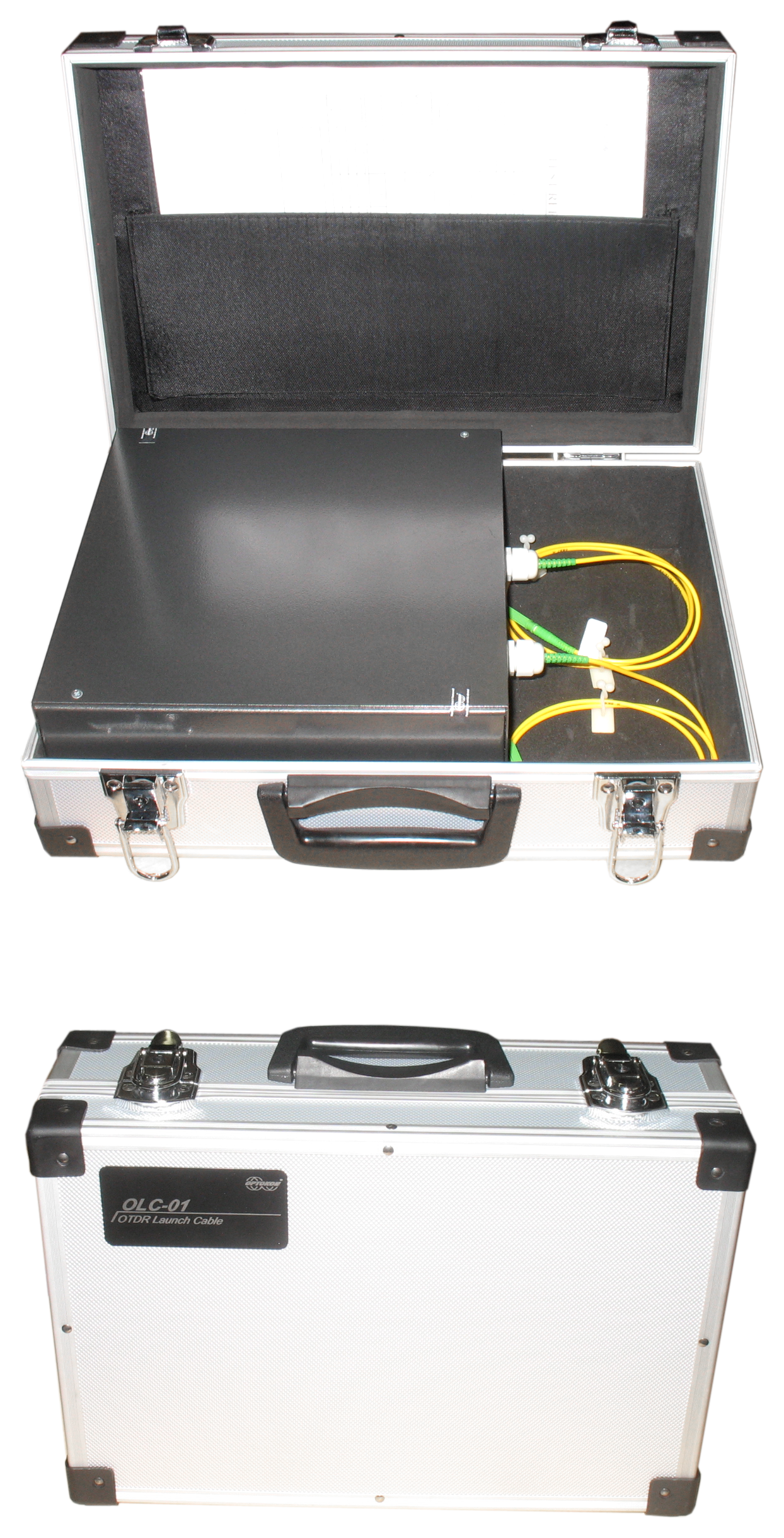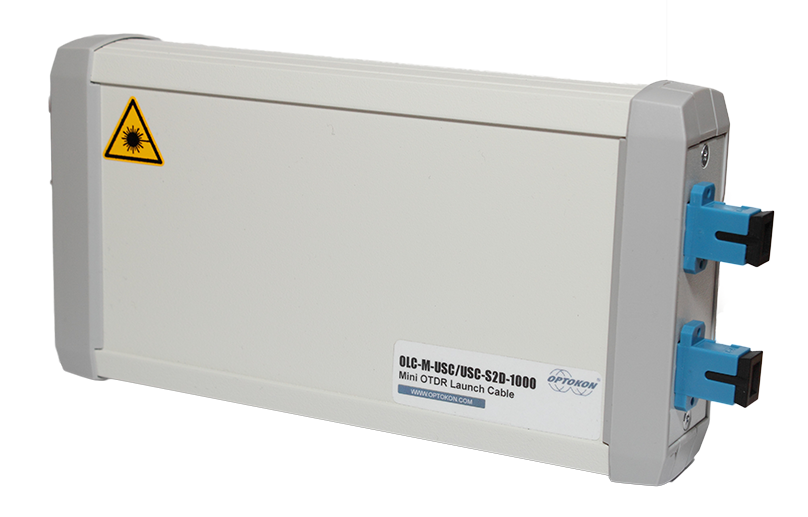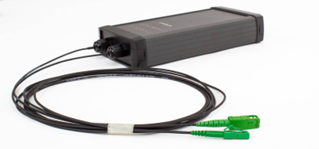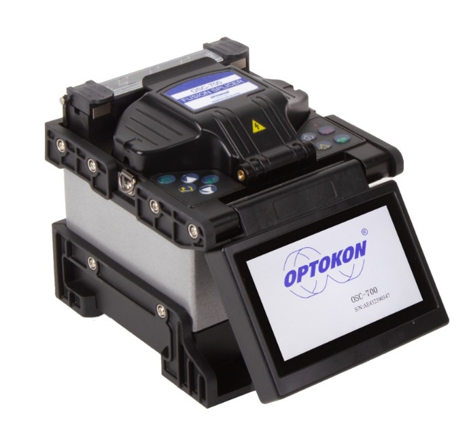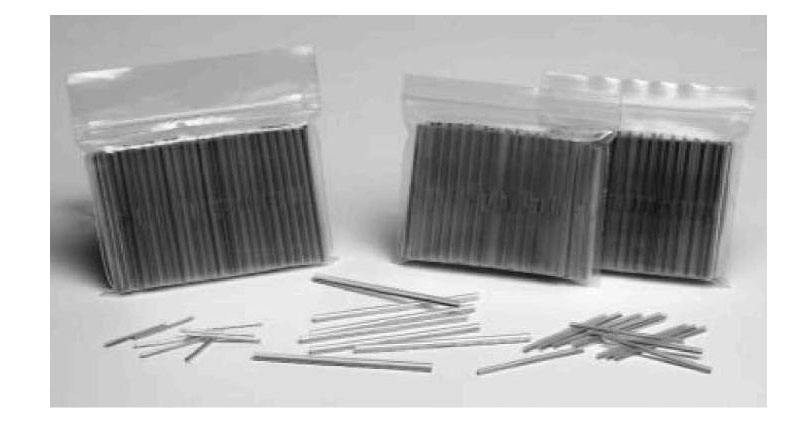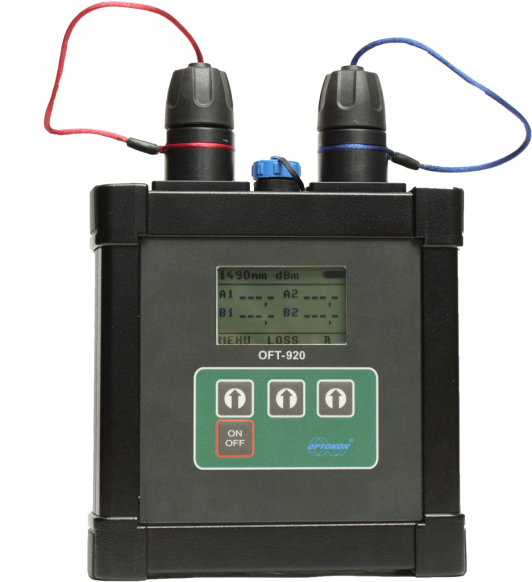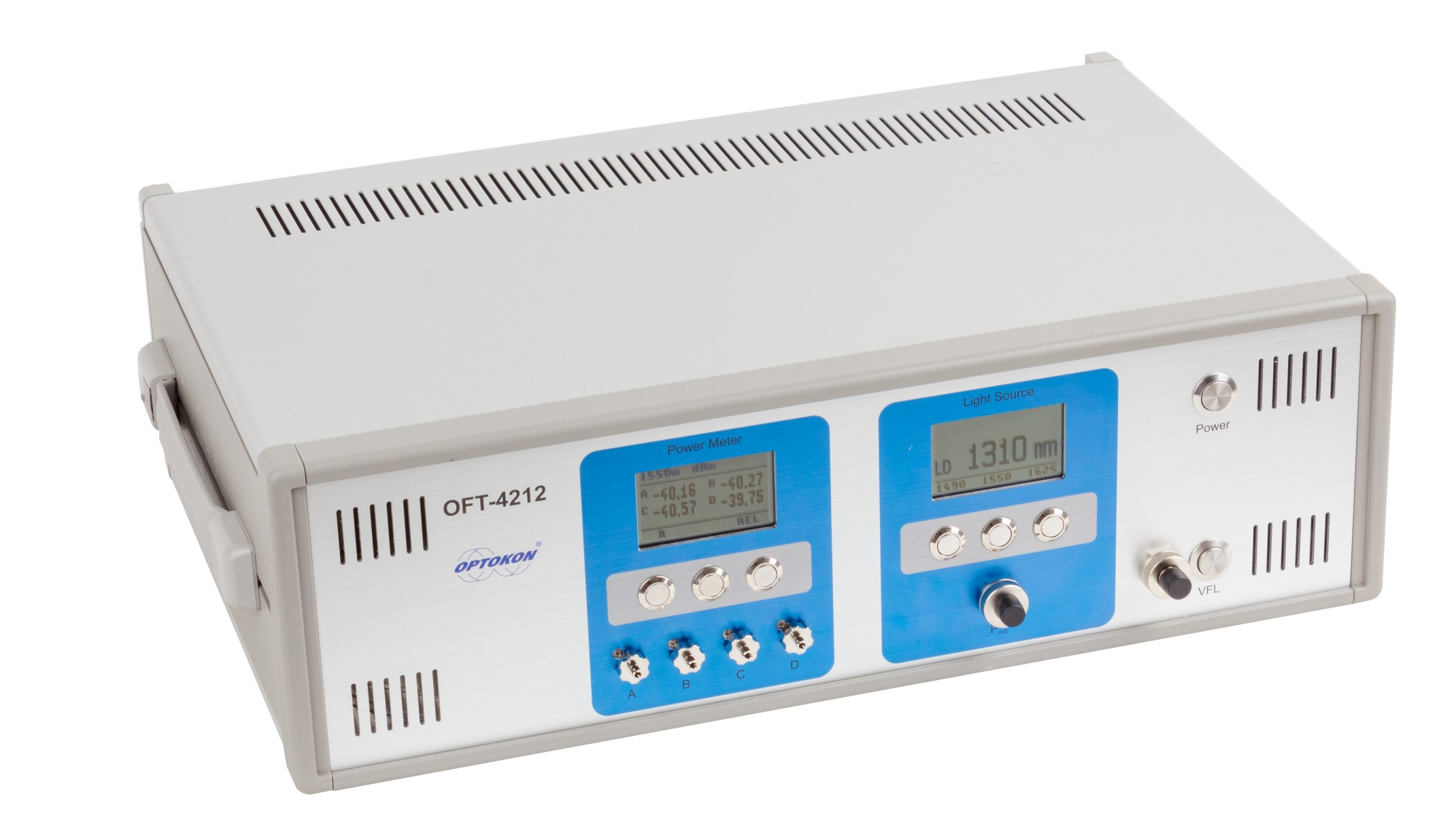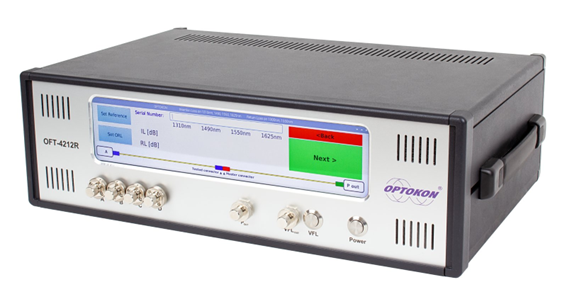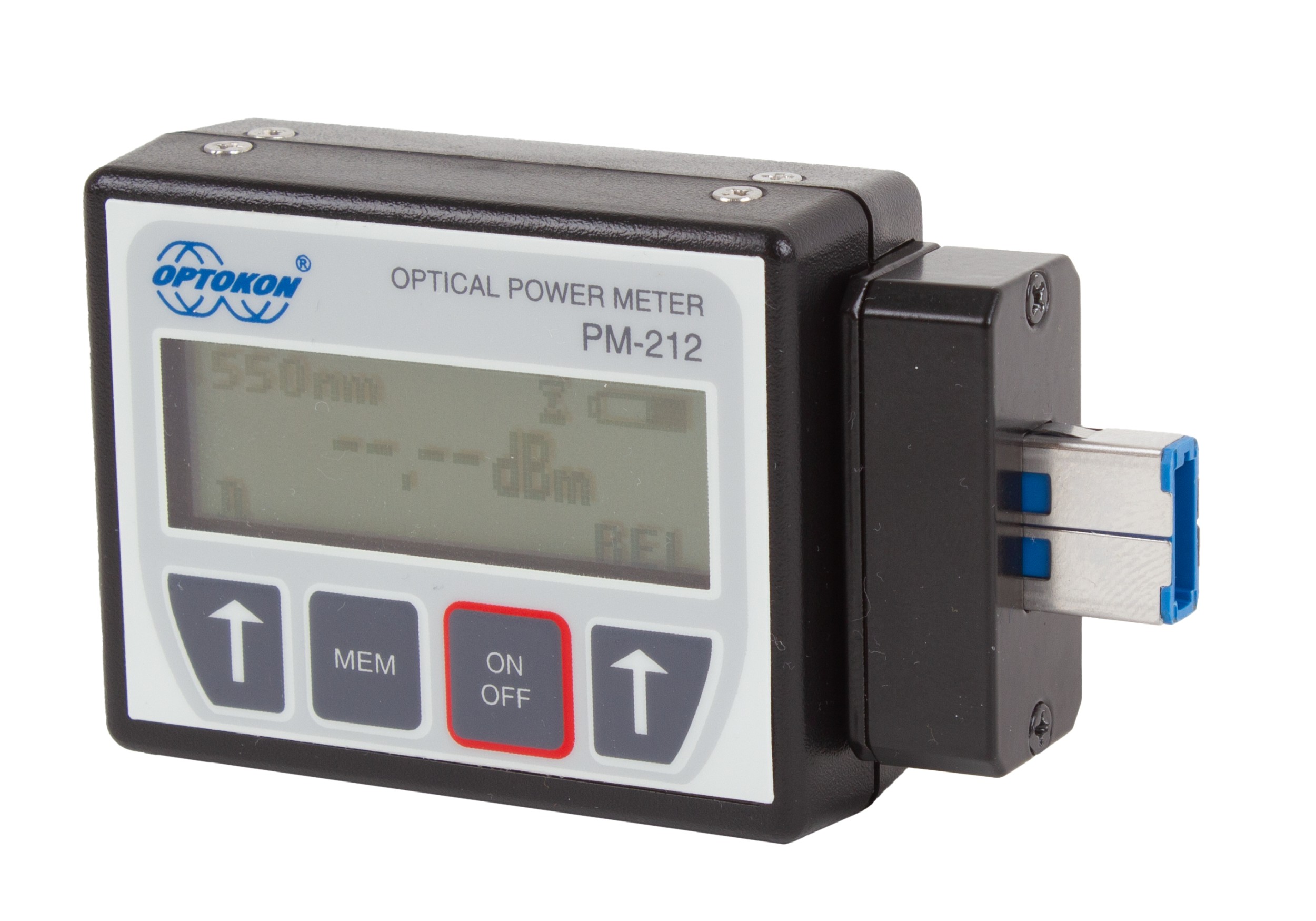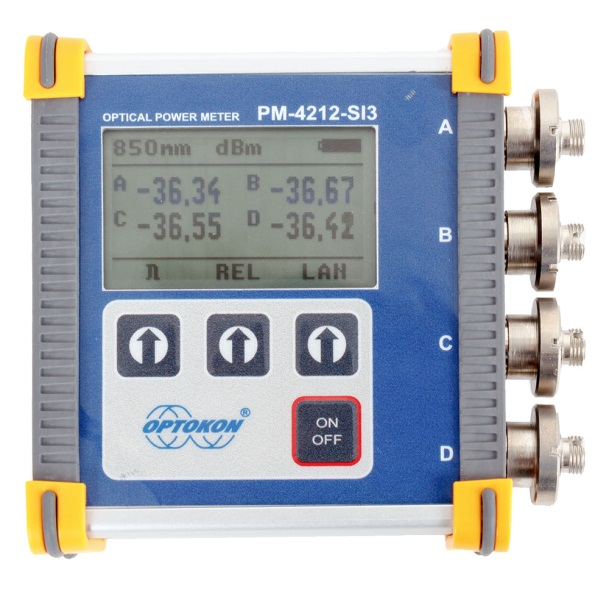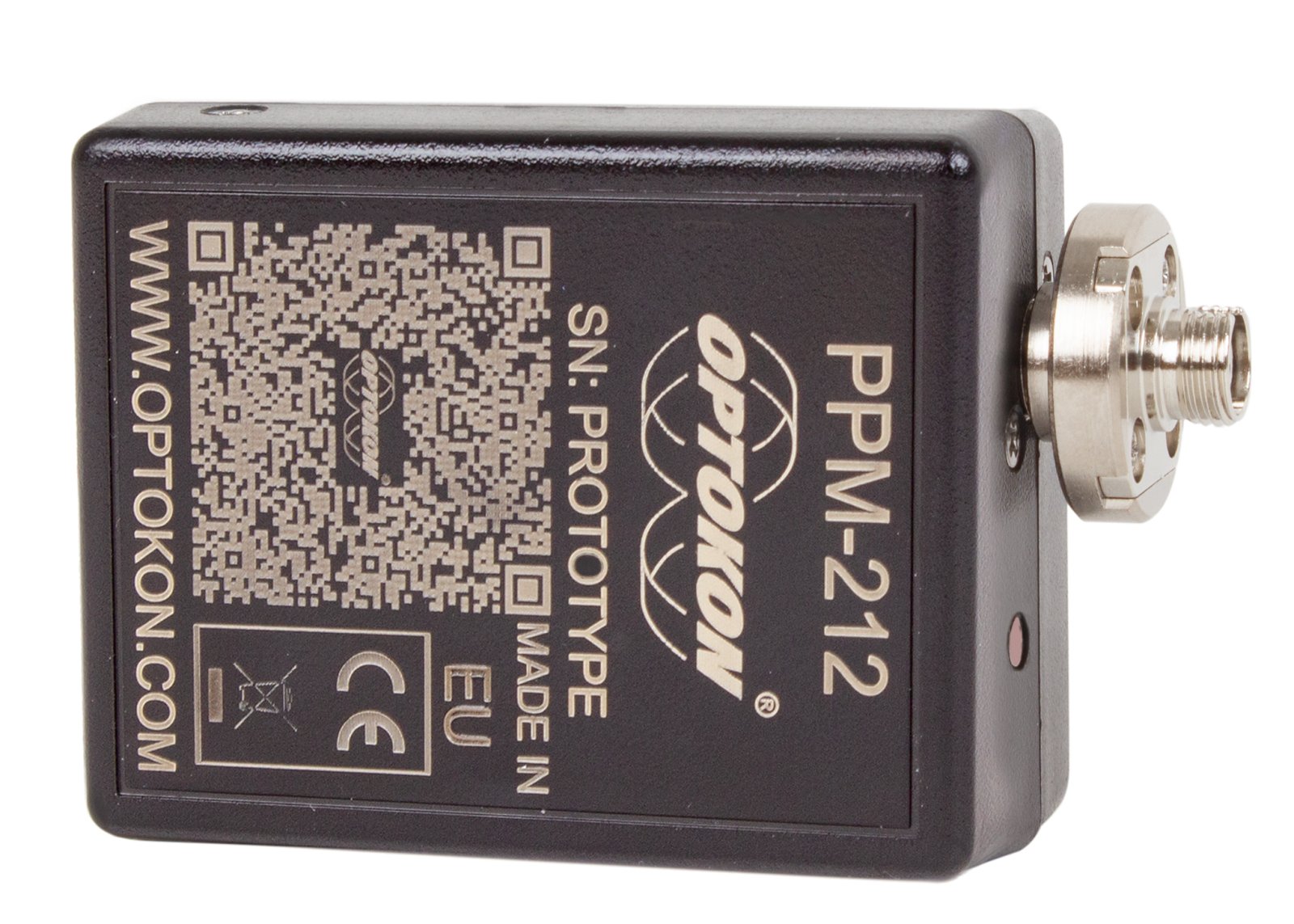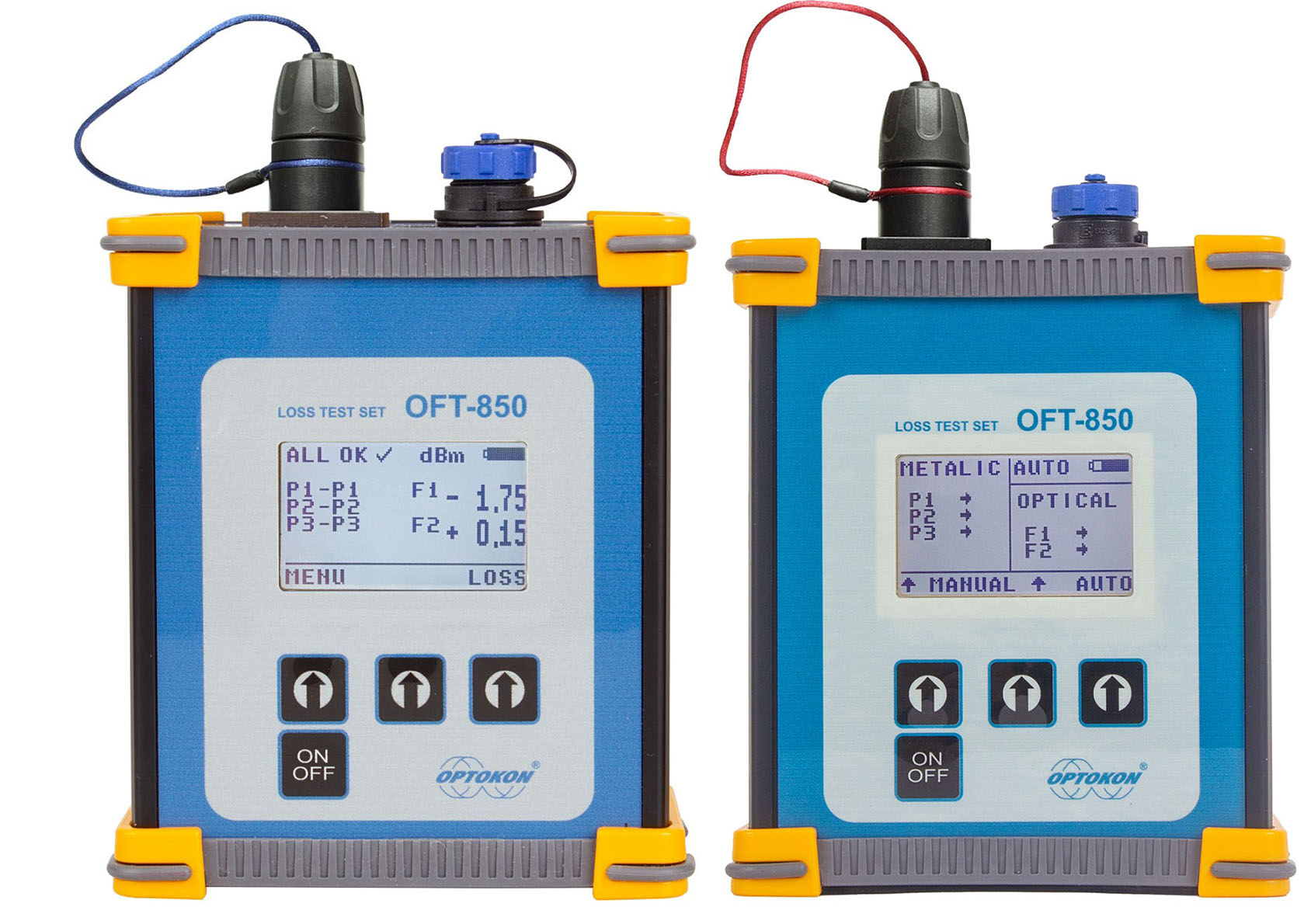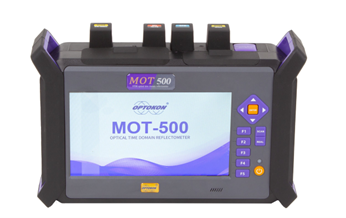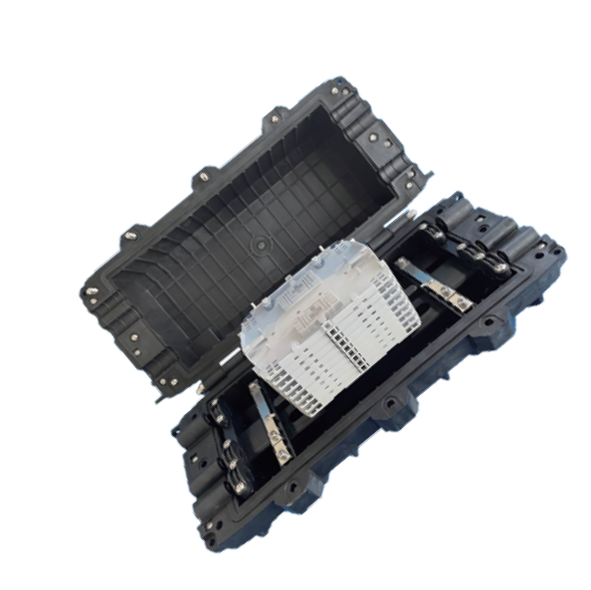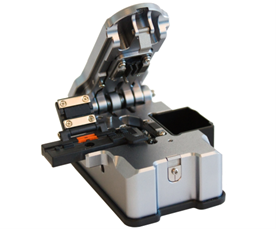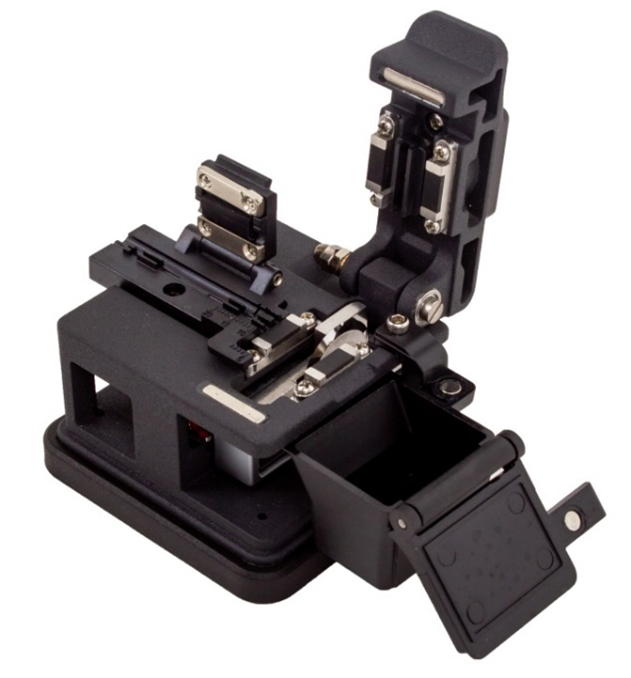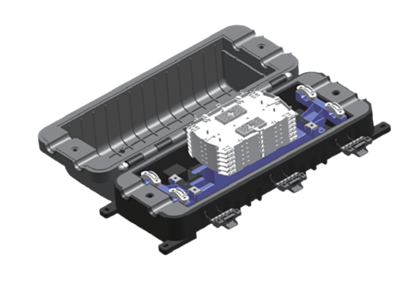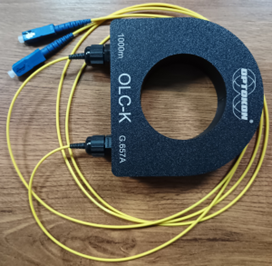PM-215E Pocket optical power meter - USB probe
The PM 215E optical power meter is a small, pocket size low cost item. The small size does not prevent the optical meter fulfilling all technical requirements for field equipment. The tester can be used as pocket power meter or as USB probe, part of testing workstation. It can be placed within rack mount ODF’s with the display on the top or on the side. The Li-Pol rechargeable battery ensures long term working time with a minimum life time of 2 years. The unit is able to store measurement data which can be uploaded to PC. The backlight function of the display facilitates the reading of measured data in poor lighting conditions.
LS-215E Pocket optical light source
The LS-215E optical Light Source is a compact and cost-effective device that meets all essential technical requirements for field equipment. It operates at wavelengths of 850/1300 nm for multimode or 1310/1550 nm for single mode applications. The rechargeable battery ensures prolonged operation with a minimum lifespan of 2 years. The batteries can be conveniently charged using a USB port or an external AC/DC adaptor.
The versatile output port facilitates the simple integration of commonly used optical adapters (FC, SC, or ST) in telecommunications, data, and industrial networks. This output port is specifically designed for the connection of connectors with a PC polished finish.
The LS-215E light source can collaborate with the PM-215E, which shares the same compact design as the smallest optical power meter. Together, they enable the measurement of insertion loss and the assessment of power budget in optical networks. The tester comes equipped with a USB port for convenient battery charging.
PM-212 Pocket optical power meter - USB probe
The PM 212 optical power meter is a small, pocket size low cost item. The small size does not prevent the optical meter fulfilling all technical requirements for field equipment. The tester can be used as pocket power meter or as USB probe, part of testing workstation. It can be placed within rack mount ODF’s with the display on the top or on the side. The Li-Pol rechargeable battery ensures long term working time with a minimum life time of 2 years. The unit is able to store 100 measurements which can be uploaded to PC and managed with SmartProtocol software or Data Exporter.
PM-212-MPO Pocket optical power meter USB probe
The PM-212-MPO optical power meter is a small, pocket size low cost item. The small size does not prevent the optical meter fulfilling all technical requirements for field equipment. The tester can be used as pocket power meter or as USB probe, part of testing workstation. The unit can be easily carried in the pocket or on the belt.
There are two versions for simultaneous measurement:
12/24 multifiber MPO/MTP connectors
16/32 multifiber MPO/MTP connectors
The Li-Pol rechargeable battery ensures long term working time with a minimum life time of 2 years. The unit is able to store 100 measurements which can be uploaded to PC and managed with SmartProtocol software or Data Exporter.
PM-212-MTP-GE Multifiber optical power meter
The PM-212-MTP-GE optical power meter is designed to measure absolute or relative optical power in optical networks terminated with multifiber MTP/MPO connectors. Because of use the large scale Ge photodiode the tester can measure overall optical power level from all fibers of MTP/MPO connectors in wide wavelength range.
There are two versions for simultaneous measurement:
12/24 multifiber MPO/MTP connectors
16/32 multifiber MPO/MTP connectors
The memory capacity allows storage and uploading of up to 100 measurements including memory position or fiber number, wavelength, absolute value or relative value and insertion loss. The SmartProtocol PC evaluation software supports memory download, test report generation and Data Exporter for data download to Excel sheet.
The rechargeable battery ensures long term working with a minimum service life of 2 years. Batteries can be charged via a USB port or external AC/DC adaptor. The controlled charging process ensures optimal battery status and extended operation time.
PM-212-SI3 Pocket optical power meter USB probe
The PM-212-SI3 optical power meter is a small, pocket size low cost tester. The small size does not prevent the optical meter fulfilling all technical requirements for field equipment. The tester can be used as pocket power meter or as USB probe, part of testing workstation. The tester is equipped with 3.6 mm Si photodetector, working area 13 mm2 designed for measurement of multimode fibers. The input interface is equipped with changeable ASP adapters, which allow connection of wide range multimode connectors. The standard tester is designed for measurement at 850/980 nm, extended wavelength range 850/880/910/940 nm is available.
The Li-Pol rechargeable battery ensures long term working time with a minimum life time of 2 years. The unit is able to store 100 measurements which can be uploaded to PC and evaluated with SmartProtocol software or Data Exporter.
PM-212-CWDM Pocket optical power meter USB probe
The PM-212-CWDM optical power meter is a small, pocket size low cost item. The small size does not prevent the optical meter fulfilling all technical requirements for field equipment. The tester can be used as pocket power meter or as USB probe, part of testing workstation. The unit can be easily carried in the pocket or on the belt. It allows simultaneous measurement of full CWDM band with 2 extra wavelengths for MM applications (850 and 1300 nm) and 1625 nm for SM. The Li-Pol rechargeable battery ensures long term working time with a minimum life time of 2 years. The unit is able to store 100 measurements which can be uploaded to PC and managed with SmartProtocol software or Data Exporter.
PM-800N Optical Power Meter
The PM-800N is a part of OPTOKON test equipment designed for thorough fiber line diagnostic. It is designed to measure absolute or relative optical power in optical networks. It can be used as a portable power meter or as a USB probe. The changeable adaptor design allows the simple exchange of optical connectors according to actual needs.
Automatic wavelength detection
Automatic wavelength detection (AWD) mode allows using OPTOKON Light source and Power meter without manually switching the measured wavelength and decreases the possibility of faulty measurement.
Cycle mode
Cycle mode allows the device to toggle between available wavelengths automatically.
The Li-Pol rechargeable battery ensures long-term working time with a minimum lifetime of 2 years. The unit can store measurement data which can be uploaded to a PC. The backlight function of the display facilitates the reading
of measured data in poor lighting conditions
LS-800N – Light Source
The LS-800N is OPTOKON test equipment designed for thorough fiber line diagnostics. The light source is available in various wavelengths. The model with one or two outputs with two light sources on each port provides a maximum of 4 wavelengths in one device. The Light source is equipped FC output adaptor as standard. The changeable adaptor design allows the simple exchange of optical connectors according to actual needs.
Automatic wavelength detection
The automatic wavelength detection (AWD) mode enables to use the OPTOKON Light Source and Power Meter without manually switching the measured wavelength and prevents faulty measurement.
Cycle mode
The cycle mode allows the device to automatically toggle between available wavelengths.
PM-830-FTTX Optical power meter
The PM-830-FTTX optical power meter is designed for simultaneous measurement and display of all signals – voice, data and video. The tester can be used as portable power meter or as USB probe, part of testing workstation. The FTTX tester is also perfect for testing PON services during activation and maintenance. The memory capacity allows storage and uploading of up to 2000 measurements. The stored data can be easily exported to Excel, Word or any other application.
Two versions of PM-830-FTTX meter available:
Single port:
The version with one input port - designed for measurement at end sides of optical lines, it requires disconnection the active device from the optical lines for measurements.
Dual port:
The version with two optical ports - the dual port tester with IN/OUT optical ports allows measurements of uninterrupted optical lines with the connected active device, pass-through testing mode. The PM-830-G1 tester is optimized for testing of standards GEPON (Gigabit EPON) and GPON, transmission speed upstream up to 1.25 Gbps. The 1310 nm channel provides correct power measurements of burst type upstream PON signals The changeable connector/adaptor design allows the simple exchange of optical PC or APC connectors (FC, SC) and easy cleaning of the output connector ferrule after removing the connector adaptor. LC/PC and LC/APC are also available.
LS-830-FTTX Optical light source
The LS-830-FTTX optical Light Source is designed for simultaneous testing of three wavelengths on optical lines, especially in FTTH-PON projects. It combines 1310 nm, 1550 nm and 1490 nm output wavelengths at one output port. In cooperation with PM-830-FTTX power meter it allows simultaneously measurement and display of all three wavelengths. If required it is possible to measure at one or two wavelengths.
The changeable connector/adaptor design allows the simple exchange of optical PC or APC connectors (FC, SC or ST) and easy cleaning of the output connector ferrule after removing the connector adaptor. LC/PC and LC/APC are also available.
PM-240-MTP Multifiber Optical Power Meter
The PM-240-MTP optical power meter is designed to measure absolute or relative optical power in optical networks terminated with 12/241 multifiber MTP/MPO connectors, in both SM and MM fibers. The tester can measure simultanously optical power level in all up to 12 fibers of MTP/MPO connectors, it can recognize “live” and “dark” fibers. It eliminates the need of fan-out from multi to single fiber connectors. Together with LS-240-MTP light source can measure Insertion loss in all 12 fibers at same time, in addition it is able to to check the polarity status of fibers interconnection between both MTP connectors. The input port ensures interconnection between measured MTP/MPO connector and 12/24 photodetectors. Due to physical contact between connectors the cleanness of both is required, preferably the visual check before measurement is suitable.
The internal memory allows measurement storage and uploading of more than 500x 12-fibers cables including cable and fiber number, wavelength, absolute value or insertion loss. The Data Exporter software allows the user to export stored data to Excel sheet, or other applications.
The rechargeable Li-Pol battery ensures long term operation with a minimum service life of 2 years. Batteries can be charged via a USB port.
LS-240-MTP Multifiber Optical Light Source
The LS-240-MTP multifiber optical Light Source is designed for testing of patchcords and cables terminated with multifiber MTP/MPO connectors. The portable testing device fulfils all necessary technical field equipment requirements. LS-240-MTP can send light one by one into all 12/241 fibers of MTP/MPO connectors, the switching process can be made manually or automatically.
Together with PM-240-MTP power meter can measure Insertion loss in all 12 fibers at same time, in addition it is able to to check the polarity status of fibers interconnection between both MTP connectors. The output port is based on standard MTP male – pins connector.
The rechargeable battery ensures long term working with a minimum life time of 2 years. Batteries can be charged via a USB port.
OFT-820N Loss Test Set
The OFT-820N series optical Loss Test Set combines two optical test equipments – Light Source and Power Meter in the same box. The optical Light Source fulfills all the necessary technical requirements for field equipment. Available in various working wavelengths combinations: 850, 1300, 1310, 1490, 1550 and 1625 nm. The optical Power Meter is designed to measure absolute or relative optical power in optical networks. The changeable adaptor design allows the simple exchange of optical connectors according actual need.
The memory capacity allows storage and uploading of up to 3000 measurements including memory position or fiber number, wavelength, absolute value or relative value and insertion loss. The rechargeable battery ensures long term working with a minimum life time of 5 years.
OFT-820-POF series Plastic optical fiber - Loss Test Set
The OFT-820N-POF series Loss Test Set is designed for POF – Plastic Optical Fiber network testing. It combines two optical test equipment – Light Source and Power Meter in the same box. The tester can be used as portable power meter or as USB probe, part of testing workstation. The optical Light Source fulfills all the necessary technical requirements for field POF network measurements. The source sends optical light into output interface, available in working wavelengths 650 nm and 850 nm at separate OUT ports. The optical Power Meter is designed to measure absolute or relative optical power in POF networks.
The memory capacity allows storage and uploading of up to 3000 measurements including memory position or fiber number, wavelength, absolute value or relative value and insertion loss. The rechargeable battery ensures long term working with a minimum life time of 2 years.
The removable and changeable IN/OUT adapters allow easy maintenance and cleaning of both ports, making the tester to be universal in wide range of application with various POF connectors. Design of both input and output adapters is the same.
OFT-840 Loss Test Set with RL
The OFT-840 series optical Loss Test Set with optical Return Loss (RL) combines optical Light Source, Power Meter and Return Loss testing in the same box. The optical Light Source fulfills all the necessary technical requirements for field equipment. Available in two working wavelengths: 1310 or 1550 nm. The optical Power Meter is designed to measure absolute or relative optical power in optical networks. The optical RL function provides extended measurement range with improved linearity. The memory capacity allows storage and uploading of up to 3000 measurements including memory position or fiber number, wavelength, absolute value or relative value and insertion loss. The SmartProtocol PC evaluation software supports memory download, test report generation and Data Exporter for data download to Excel sheet.
OFT-850 SMPTE Hybrid Cable Test Set
The OFT-850 set consists of SMPTE SOURCE and SMPTE TESTER unit. The hybrid cable tester is designed for testing of loss in optical fibers and checking of continuity of copper pairs in hybrid cables. It combines optical light source on one side, optical power meter on other side and copper wires checker. It is ideal for testing large spaces of LEMO SMPTE Hybrid System for Broadcast Infrastrucutre Networks.
The ruggedized aluminium case makes the unit ideal for field operation. The memory capacity allows storage and uploading of more than 1000 measurements including cable number, result of metalic wires check and optical power value or insertion loss. The tester supports memory download and test report generating. The Lithium rechargeable battery ensures long term working with minimal operation costs.
WST.TE.HDTV SMPTE Hybrid cable checker
Made exclusively for LEMO
The WST HYBRID CABLE CHECKER set consists of an SMPTE measuring unit and an SMPTE loopback. The hybrid cable checker is designed for testing optical power level in optical fibers and the continuity of copper pairs in hybrid cables. It combines an optical light source, optical detector, and copper wires checker.
It is ideal for testing large spaces of the LEMO SMPTE Hybrid System for Broadcast Infrastructure Networks. The ruggedized aluminium case makes the unit ideal for field operation. The Lithium rechargeable battery ensures long term working with minimum operating costs.
FOI-400W - Fiber Optic Microscope WiFi Version
The fiber end face inspector is designed for ferrule end face inspection with excellent performance and convenient operability. It magnifies the object by 260 to 400 times making it easier to assess the status of the fiber end face. The compact size makes it the ideal tool for connector end face inspection before and during fiber network installation. Various adapter types can be used for inspecting male fiber connectors & female fiber connectors, such as FC, SC, ST, LC. The OPTOKON FOI-400W microscope might be connected via USB and Wi-Fi to PC and Smartphone/Tablet, both Android and Apple operating system. The SW allows the storage of the inspected connectors for later evaluation and reporting protocols and Pass/Fail Analysis according to IEC 61300-3-35 standard. The OPTOKON FOI-400W microscope will work for 4 hours with a 3.7 V rechargeable Li-Pol battery.
FOI-400AC AutoCheck Microscope
AutoCheck is the intelligent integrated fiber end face inspector with the advantages of analysis software and high performance embedded system. AutoCheck can identify the tiny defects accurately, conveniently and simply. The fiber end face inspection complies with IEC standards and customized criteria.
OLC – PE OTDR Launch Cable
If you are installing an outside plant network such as a long-distance network or a long campus LAN with splices between cables, you will want an OTDR to check if the fibers and splices are good. The OTDR can see the splice after it is made and confirm its performance. It can also find stress problems in the cables caused by improper handling during installation. If you are doing restoration after a cable cut, the OTDR will help find the location of the cut and help confirm the quality of temporary and permanent splices to restore operation. On single mode fibers where
connector reflections are a concern, the OTDR will pinpoint bad connectors easily.
Since so little light comes back to the OTDR for analysis, the OTDR receiver circuit must be very sensitive. That means that big reflections, which may be one percent of the outgoing signal, will saturate or overload the receiver. Once saturated, the receiver requires some time to recover; until it does, the trace is unreliable for measurement.
The most common place you see this as a problem is caused by the connector on the OTDR itself. The reflection causes an overload which can take the equivalent of 50 meters to one kilometer to recover fully, depending on the OTDR design, wavelength and magnitude of the reflection. It is usually called the "Dead Zone". For this reason, most OTDR manuals suggest using a "pulse suppresser" cable, which doesn't suppress pulses but simply gives the OTDR time to recuperate before you start looking at the fiber in the cable plant you want to test. They should be called "launch" cables.
Do not ever use an OTDR without this launch cable! You always want to see the beginning of the cable plant and you cannot do it without a launch cable. It allows the OTDR to settle down properly and gives you a chance to see the condition of the initial connector on the cable plant. It should be long, at least 500 to 1000 meters to be safe, and the connectors on it should be the best possible to reduce reflections. They must also match the connectors being tested if they use any special polish techniques.
OLC - 01 OTDR Launch Cable
If you are installing an outside plant network such as a long distance network or a long campus LAN with splices between cables, you will want an OTDR to check if the fibers and splices are good. The OTDR can see the splice after it is made and confirm it's performance. It can also find stress problems in the cables caused by improper handling during installation. If you are doing restoration after a cable cut, the OTDR will help find the location of cut and help confirm the quality of temporary and permanent splices to restore operation. On singlemode fibers where connector reflections are a concern, the OTDR will pinpoint bad connectors easily.
Since so little of the light comes back to the OTDR for analysis, the OTDR receiver circuit must be very sensitive. That means that big reflections, which may be one percent of the outgoing signal, will saturate the receiver, or overload it. Once saturated, the receiver requires some time to recover, and until it does, the trace is unreliable for measurement.
The most common place you see this as a problem is caused by the connector on the OTDR itself. The reflection causes an overload which can take the equivalent of 50 meters to one kilometer to recover fully, depending on the OTDR design, wavelength and magnitude of the reflection. It is usually called the "Dead Zone". For this reason, most OTDR manuals suggest using a "pulse suppresser" cable, which doesn't suppress pulses, but simply gives the OTDR time to recuperate before you start looking at the fiber in the cable plant you want to test. They should be called "launch" cables.
Do not ever use an OTDR without this launch cable! You always want to see the beginning of the cable plant and you cannot do it without a launch cable. It allows the OTDR to settle down properly and gives you a chance to see the condition of the initial connector on the cable plant. It should be long, at least 500 to 1000 meters to be safe, and the connectors on it should be the best possible to reduce reflections. They must also match the connectors being tested, if they use any special polish techniques.
OLC - D OTDR Launch Cable
If you are installing an outside plant network such as a long distance network or a long campus LAN with splices between cables, you will want an OTDR to check if the fibers and splices are good. The OTDR can see the splice after it is made and confirm its performance. It can also find stress problems in the cables caused by improper handling during installation. If you are doing restoration after a cable cut, the OTDR will help find the location of cut and help confirm the quality of temporary and permanent splices to restore operation. On singlemode fibers where connector reflections are a concern, the OTDR will pinpoint bad connectors easily.
Since so little of the light comes back to the OTDR for analysis, the OTDR receiver circuit must be very sensitive. That means that big reflections, which may be one percent of the outgoing signal, will saturate the receiver, or overload it. Once saturated, the receiver requires some time to recover, and until it does, the trace is unreliable for measurement.
The most common place you see this as a problem is caused by the connector on the OTDR itself. The reflection causes an overload which can take the equivalent of 50 meters to one kilometer to recover fully, depending on the OTDR design, wavelength and magnitude of the reflection. It is usually called the "Dead Zone". For this reason, most OTDR manuals suggest using a "pulse suppresser" cable, which doesn't suppress pulses, but simply gives the OTDR time to recuperate before you start looking at the fiber in the cable plant you want to test. They should be called "launch" cables.
Do not ever use an OTDR without this launch cable! You always want to see the beginning of the cable plant and you cannot do it without a launch cable. It allows the OTDR to settle down properly and gives you a chance to see the condition of the initial connector on the cable plant. It should be long, at least 500 to 6000 meters to be safe, and the connectors on it should be the best possible to reduce reflections. They must also match the connectors being tested, if they use any special polish techniques.
OLC - M Mini OTDR Launch Cable
If you are installing an outside plant network such as a long distance network or a long campus LAN with splices between cables, you will want an OTDR to check if the fibers and splices are good. The OTDR can see the splice after it is made and confirm its performance. It can also find stress problems in the cables caused by improper handling during installation. If you are doing restoration after a cable cut, the OTDR will help find the location of cut and help confirm the quality of temporary and permanent splices to restore operation. On singlemode fibers where connector reflections are a concern, the OTDR will pinpoint bad connectors easily.
Since so little of the light comes back to the OTDR for analysis, the OTDR receiver circuit must be very sensitive. That means that big reflections, which may be one percent of the outgoing signal, will saturate the receiver, or overload it. Once saturated, the receiver requires some time to recover, and until it does, the trace is unreliable for measurement.
The most common place you see this as a problem is caused by the connector on the OTDR itself. The reflection causes an overload which can take the equivalent of 50 meters to one kilometer to recover fully, depending on the OTDR design, wavelength and magnitude of the reflection. It is usually called the "Dead Zone". For this reason, most OTDR manuals suggest using a "pulse suppresser" cable, which doesn't suppress pulses, but simply gives the OTDR time to recuperate before you start looking at the fiber in the cable plant you want to test. They should be called "launch" cables.
Do not ever use an OTDR without this launch cable! You always want to see the beginning of the cable plant and you cannot do it without a launch cable. It allows the OTDR to settle down properly and gives you a chance to see the condition of the initial connector on the cable plant. It should be long, at least 500 to 1000 meters to be safe, and the connectors on it should be the best possible to reduce reflections. They must also match the connectors being tested, if they use any special polish techniques. The OLC-M, compact pocket size OTDR launch cable is designed for easy handling and carrying. Its robust design ensures reliability and endurance. Protective caps helps keeping connectors clean. This launch cable is fully compatible with almost all OTDRs. Specially with OPTOKON MOT-700 Mini OTDR series the OLC-M introduces an useful and powerful set for OTDR measuring in optical networks.
OLC - M(P) Mini OTDR Launch Cable
If you are installing an outside plant network such as a long distance network or a long campus LAN with splices between cables, you will want an OTDR to check if the fibers and splices are good. The OTDR can see the splice after it is made and confirm its performance. It can also find stress problems in the cables caused by improper handling during installation. If you are doing restoration after a cable cut, the OTDR will help find the location of cut and help confirm the quality of temporary and permanent splices to restore operation. On singlemode fibers where connector reflections are a concern, the OTDR will pinpoint bad connectors easily.
OLC-P-NLC/NSC-S7A-500
Since so little of the light comes back to the OTDR for analysis, the OTDR receiver circuit must be very sensitive. That means that big reflections, which may be one percent of the outgoing signal, will saturate the receiver, or overload it. Once saturated, the receiver requires some time to recover, and until it does, the trace is unreliable for measurement.
The most common place you see this as a problem is caused by the connector on the OTDR itself. The reflection causes an overload which can take the equivalent of 50 meters to one kilometer to recover fully, depending on the OTDR design, wavelength and magnitude of the reflection. It is usually called the "Dead Zone". For this reason, most OTDR manuals suggest using a "pulse suppresser" cable, which doesn't suppress pulses, but simply gives the OTDR time to recuperate before you start looking at the fiber in the cable plant you want to test. They should be called "launch" cables.
Do not ever use an OTDR without this launch cable! You always want to see the beginning of the cable plant and you cannot do it without a launch cable. It allows the OTDR to settle down properly and gives you a chance to see the condition of the initial connector on the cable plant. It should be long, at least 500 to 1000 meters to be safe, and the connectors on it should be the best possible to reduce reflections. They must also match the connectors being tested, if they use any special polish techniques.
The OLC-M/P, compact pocket size OTDR launch cable is designed for easy handling and carrying. Its robust design ensures reliability and endurance. Protective caps helps keeping connectors clean. This launch cable is fully compatible with almost all OTDRs.
Specially with OPTOKON MOT-500 Mini OTDR series the OLC-M/P introduces an useful and powerful set for OTDR measuring in optical networks.
OLC-AF Attenuation Reference Fiber (ARF)
The OLC-AF, attenuation reference fiber is designed for the calibration of the attenuation scale of SM OTDR. The OLC-AF is wind from defined length of G.652 Single mode fiber or OM2 Multimode fiber. The OLC-AF consists in a fiber spool of a defined attenuation at required wavelength, which is installed in a thermally shielded rack mount optical distribution frame for better stability. The reference fiber is fitted with two APC connectors for single mode and PC connectors for multimode. The attenuation is calibrated at 1310 nm for SM or at 850 nm for MM.
OSC-700 Single Fiber Fusion Splicer
The OPTOKON OSC-700 is an automatic fusion splicer for SM, MM, DS, NZ-DS (G655), EDF and other fibers. The OSC-700 can ensure high-quality splicing even in the most unfavourable environmental conditions. The OSC-700 splicers are suitable for core or cladding alignment. Using one of these methods the two cleaved fibers are automatically aligned by the fusion splicer in the X, Y plane, then are fused together. The bare fiber area is protected either by recoating or with a splice protector. A splice protector is a heat shrinkable tube with a strength member and less loss.
Fusion Splice Sleeves P-Series
OPTOKON offers the industry's highest quality fusion splice sleeves and holders. Standard sleeves are constructed with a stainless steel strength member, polyolefin copolymer inner tube and a polyolefin outer tube. Cut lengths are precise and all ends are free from burrs and sharp edges. Standard Sleeves are heat bonded to ensure tubes maintain perfect alignment during shipping, handling and shrinking. Sleeves are available in custom lengths, colors and diameters.
OFT-920 Ruggedized Optical Test Set
The OFT-920 ruggedized optical test set is designed for testing of optical networks terminated with connectors operating in harsh environment. It combines both light source and optical power meter in one common box. The test set is designed to meet the mining, petrochemical and broadcast industry demand. The ruggedized aluminium case makes the unit ideal for field operation.
The memory capacity allows storage and uploading of up to 2000 measurements including memory position or fiber number, wavelength, absolute value or relative value and insertion loss. The tester supports memory download and test report generating. The rechargeable battery ensures long term working with minimal operation costs.
OFT-4212-MCMU Fiber optic 16 channels optical test station
OFT-4212-MCMU is a connector assembly test station, equipped with set of Light sources, Optical Return Loss module, 16 channels power meter and control unit with touch display. This solution provides full automated test of connector with graphical guidance. Serial numbers of tested connectors can be entered manually or by QR code reader. Measured values are checked if they are within expected range, then displayed in GREEN or RED color as a warning. If there is a warning, the measurement can be easily repeated. All measured data are automatically stored on local SSD.
OFT-4212 Fiber optic 4-channels optical testing system
The OFT-4212 introduces monitoring and testing system designed for long term measurement of time depending changes of optical power level. The system includes four input channels Power meter, Light source and reporting software – Optical Power Monitor. The system is available with 2 multimode 850/1300 nm or 4 single mode 1310/1490/1550/1625 nm working wavelengths.
The optical Power Meter is designed to measure absolute or relative optical power in four optical fibers at the same time. The OPM – Optical Power Monitor software allows monitoring of all four fibers at multiple wavelengths simultaneously. The measured data are recorded with TimeStamp which includes date and time of measurement. The results can be stored and easily exported into spreadsheets for Reports elaboration.
In addition the OFT-4212 is equipped with 650 nm visible light source for fiber visual check.
OFT-4212R Fiber optic 4 channels optical test station
OFT4212R is a connector assembly test station, equipped with set of Light sources, Optical Return Loss module, four channel power meter and control unit with touch display.
This solution provides full automated test of connector with graphical guidance. Serial numbers of tested connectors can be entered manually or by QR code reader. Measured values are checked if they are within expected range, then displayed in GREEN or RED color as a warning. If there is a warning, the measurement can be easily repeated. All measured data are automatically stored on local SSD.
Applications:
Connector test with Insertion loss at 1310, 1490, 1550 and 1625 nm, Return loss at 1310 and 1550 nm
PLS-30 Precise Optical Light Source
The PLS-30 includes the precise optical light sources designed for laboratory use. The customized design allows implementation of required optical sources in a 1U frame, which can be installed inside a 19” rack or used as a desktop in wide range of fiber testing systems. The PLS-30 provides an automatic power control loop to keep output power constant. The light source output ports are available on the front panel in separate FC/APC (SM) or FC/PC (MM) connector adapters or in one common port, with a switchable wavelength using an internal optical switch. The removable connector adaptor design allows the simple exchange of optical output adapters and easy maintenance and cleaning of the output connector ferrule after removing the connector adaptor.
PM-212-SN-GE Multifiber optical power meter
The PM-212-SN-GE optical power meter is designed to measure absolute or relative optical power in optical networks terminated with duplex SN connectors. Because of use the large scale Ge photodiode the tester can measure overall optical power level from both fibers of SN connectors in wide wavelength range.
The memory capacity allows storage and uploading of up to 100 measurements including memory position or fiber number, wavelength, absolute value or relative value and insertion loss. The SmartProtocol PC evaluation software supports memory download, test report generation and Data Exporter for data download to Excel sheet.
The rechargeable battery ensures long term working with a minimum service life of 2 years. Batteries can be charged via a USB port or external AC/DC adaptor. The microprocessor controlled charging process ensures optimal battery status and extended operation time.
PM-4212 – Compact 4 port optical power meter
The PM-4212 is a 4 port portable optical power meter. The small size does not prevent the optical power meter fulfilling the operational requirements of a full size tester.
The power meter is designed for simultaneous measurement of up to 4 single mode or multimode fibers. All four input interfaces are fitted with 1mm InGaAs photo detectors, with changeable ADP adapters for a wide range of single mode and multimode fiber connectors.
The tester can be used as standalone power meter or as part of a testing workstation. Communication with control software is through the USB port or an Ethernet network.
PM-4212-SI3 Compact 4 port optical power meter
The PM-4212-SI3 is a 4 port portable optical power meter. The small size does not prevent the optical power meter fulfilling the operational requirements of a full size tester.
The power meter is designed for simultaneous measurement of up to 4 multimode fibers. All four input interfaces are fitted with 3.6 mm Si photo detectors, each with a 13 mm2 working area and with changeable TE-ASP adapters for a wide range of MM fiber connectors.
The tester can be used as standalone power meter or as part of a testing workstation. Communication with control software is through the USB port or an Ethernet network
PPM-212 Pocket optical power meter USB probe
The PPM-212 optical power meter – USB probe is a small, compact tester without display and
battery. The tester is designed to be used as USB probe, part of testing workstation. The small size does
not prevent the optical meter fulfilling all technical requirements.
The tester is equipped with USB interface. It ensures power supply, data reading and transferring
into data processing SW.
Standard optical interface is equipped with FC/PC adapter, which ensures proper connection of testing
cable. It might be easily changed by universal 2.5/1.25 μm ferrule or any commonly used type.
The multicolor LED is signalizing power supply, absolute (dBm) or relative (dB) measuring mode.
OFT-850K Hybrid Cable Test Set
The OFT-850K set consists of SOURCE and TESTER unit. The hybrid cable tester is designed for testing of loss in optical fibers and checking of continuity of copper pairs in hybrid cables. It combines optical light source on one side, optical power meter on other side and copper wires checker. It is ideal for testing of Hybrid System based on cables, which include optical fibers and copper wires. The ruggedized aluminium case makes the unit ideal for field operation. The memory capacity allows storage and uploading of more than 1000 measurements including cable number, result of metalic wires check and optical power value or insertion loss. The tester supports memory download and test report generating. The Lithium rechargeable battery ensures long term working with minimal operation costs.
PM-800-G optical Power Meter
The PM-800-G is a members of OPTOKON test equipment family designed for thorough fiber optic line diagnostic. Both are designed to measure absolute or relative optical power in optical networks. It can be used as portable power meter or as a USB probe. The changeable adaptor design allows the simple exchange of optical connectors according actual need.
Automatic wavelength detection
Automatic wavelength detection (AWD) mode allows using OPTOKON Light source and Power meter without manually switching the measured wavelength and decreases the possibility of faulty measurement.
MOT-500 Mini OTDR series
MOT-500 series Optical Time Domain Reflectometer (OTDR) is an intelligent meter of a new generation for the detection of fiber communications systems. With the popularization of optical network installed in cities and countryside’s, the measurement of optical network becomes short and disperses; MOT-500 is specially designed for that kind of application. It’s economic, having outstanding performance.
MOT-500 is manufactured with patience and carefulness, following the national standards to combine the rich experience and modern technology, subject to stringent mechanical, electronic and optical testing and quality assurance; in the other way, the new design makes MOT-500 more smart and compact and multi-purpose.
Whether you want to detect link layer in the construction and installation of optical network or proceed efficient maintenance and troubleshooting, MOT-500 can be your best assistant.
KSHT-H116 Fiber Optic Splice Closure
- May be used for cut, uncut and taut sheath applications
- It may be used for all fibre optic cable
- Sheath retention & central strength member fasten system included
- Ribbed closure construction and lightweight plastic provide strength and resistance to chemical and U.V attack
- Installation and reentry with a minimum of tools
- All hardware is included
- Re-enterable and reusable
- RoHS compliance
MOT-200 Mini OTDR series
The MOT-200 series Optical Time Domain Reflectometer (OTDR) is a next-generation intelligent meter designed for detecting fiber communication systems. As optical networks expand in urban and rural areas, measurements become shorter and more dispersed; the MOT-200 is specifically tailored for these applications. It is cost-effective and delivers exceptional performance.
Manufactured with meticulous care, the MOT-200 adheres to national standards, integrating extensive experience with modern technology. It undergoes rigorous mechanical, electronic, and optical testing and quality assurance. The new design makes the MOT-200 smarter, more compact, and versatile.
Whether you need to detect the link layer during the construction and installation of optical networks or perform efficient maintenance and troubleshooting, the MOT-200 is your ideal assistant.
OCL-610 Fiber Cleaver
The OPTOKON OCL-610 series high precision fiber cleaver is the highly-precision fiber cutting tool, suitable for 200 µm up to 900 µm coating fiber and 125 µm cladding fiber.
The OCL-610 cleaver together with the OSC-700 fusion splicer and other necessary tools, forms part of a splice kit designed for installation of fiber optic networks. The complete set is delivered in a rugged carrying case. With a great deal of value and high performance, the kit is available for a wide range of users – installers and operators. It can be used advantageously for the installation of cables with several fibers in FTTH access networks up to high-capacity cables of long-haul backbone optical lines.
OCL-100 Fiber Cleaver
The OPTOKON OCL-100 series high precision fiber cleaver is the highly-precision fiber cutting tool, suitable for 200 µm up to 900 µm coating fiber and 125 µm cladding fiber. The 16-position blade is workable for 48 000 fiber cleaves. It is easy to use and maintenance.
The OCL-100 cleaver together with the OSC-700 fusion splicer and other necessary tools, forms part of a splice kit designed for installation of fiber optic networks. The complete set is delivered in a rugged carrying case. With a great deal of value and high performance, the kit is available for a wide range of users – installers and operators. It can be used advantageously for the installation of cables with several fibers in FTTH access networks up to high-capacity cables of long haul backbone optical lines.
KSHT-122 Fiber Optic Splice Closure
- May be used for cut, uncut and taut sheath applications
- May be used for all fiber optic cables
- Sheath retention & central strength member fasten system included
- Ribbed closure construction and lightweight plastic provides strength and resistance to chemical and U.V attack
- Installation and reentry with a minimum of tools
- All hardware is included
- Re-enterable and reusable
- RoHS compliance
OLC-K Mini OTDR Launch Cable
If you are installing an outside plant network such as a long distance network or a long campus LAN with splices between cables, you will want an OTDR to check if the fibers and splices are good. The OTDR can see the splice after it is made and confirm its performance. It can also find stress problems in the cables caused by improper handling during installation. If you are doing restoration after a cable cut, the OTDR will help find the location of cut and help confirm the quality of temporary and permanent splices to restore operation. On single mode fibers where connector reflections are a concern, the OTDR will pinpoint bad connectors easily.
Since so little of the light comes back to the OTDR for analysis, the OTDR receiver circuit must be very sensitive. That means that big reflections, which may be one percent of the outgoing signal, will saturate the receiver, or overload it. Once saturated, the receiver requires some time to recover, and until it does, the trace is unreliable for measurement.

